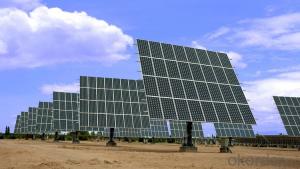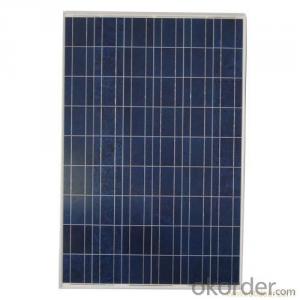Dye-Sensitized Solar Cells Favorites Compare Best Price per Watt Solar Panels 250W for Grid Tied Solar System
- Loading Port:
- China Main Port
- Payment Terms:
- TT OR LC
- Min Order Qty:
- -
- Supply Capability:
- 10000000000000 watt/month
OKorder Service Pledge
OKorder Financial Service
You Might Also Like
Quick Details
| Place of Origin: | Guangdong China (Mainland) | Brand Name: | CAP | Model Number: | 50w100w150w200w250w300w |
| Material: | Monocrystalline Silicon | Size: | 1385*1035*75mm | Number of Cells: | 72pcs |
| Max. Power: | 300w | type: | solar panel | color: | blue&black |
| warranty: | 5 years |
Packaging & Delivery
| Packaging Detail: | standard export package for solar panel |
| Delivery Detail: | 7-15 days for solar panel |
Specifications
solar panel
High Efficiency
25 years Warranty
High-transmissivity low-iron tempered glass
Solar Panel
50w100w150w200w250w300w
Characteristics
1,High and stable conversion efficienly based on over 4 years professional experience
2 ,High reliability with guaranteed +/-10% output power tolerance
3,Proven materials,tempered front glass,and a sturdy anodized aluminum frame allow modules to operate reliably in multiple mountily configurations
4,Combination of high efficicncy and attractive appearance
Quality and Safety
1,25 year 80%,10 year 90% power warranty 3 year power warranty
2,ISO9001:2000 (Quality Management system) certified factory
3,Product Quality warranty & products Liability Insurance to guarantee and user' benefits
4,Certifications TUV Intercert, CE Temperature Coefficients
| Module Type | 100w | 150w | 200w | 250w | 300w |
| Maximum Power at ST(Pmax)W | 100wp | 150wp | 200wp | 250wp | 300wp |
| Maximum Power Voltage(Vmp)V | 36/18 | 36/18 | 36/18 | 30.8v | 36/18 |
| Maximum Power Current(Imp)A | 2.77/5.55 | 4.16/8.33 | 5.55/11.1 | 8.11A | 8.33/16.66 |
| Open Circuit Voltage(Voc)V | 39.5/19.05 | 39.3/19.4 | 39.6/19.5 | 36.2V | 39.6/19.8 |
| Short Circuit Current(Isc)A | 3.04/6.09 | 4.58/9.16 | 6.1/12.2 | 8.7A | 9.16/18.33 |
| Cell Efficiency(%) | 18.60% | 18.10% | 18.60% | 17.80% | 18.10% |
| Module Efficiency(%) | 17.70% | 17.20% | 17.70% | 17.10% | 17.20% |
| Operating Temperature°C | -40°C to +85°C | -40°C to +85°C | -40°C to +85°C | -40°C to +85°C | -40°C to +85°C |
| Maximum system voltage | 1000V(IEC)DC | 1000V(IEC)DC | 1000V(IEC)DC | 1000V(IEC)DC | 1000V(IEC)DC |
| Power tolerance | -0.03 | -0.03 | -0.03 | -0.03 | -0.03 |
| Temperature coefficients of Pmax | -0.45%/°C | -0.45%/°C | -0.45%/°C | -0.45%/°C | -0.45%/°C |
| Temperature coefficients of Voc | -0.27%/°C | -0.27%/°C | -0.27%/°C | -0.27%/°C | -0.27%/°C |
| Temperature coefficients of Isc | 0.05%/°C | 0.05%/°C | 0.05%/°C | 0.05%/°C | 0.05%/°C |
| Weight(kg) | 8 | 11 | 14 | 20 | 25.5 |
| Number of cell(pcs) | 4*9 | 4*9 | 6*10 | 6*12 | 6*12 |
| Dimensions(mm) | 1194*534*35/30 | 1580*808*50/35 | 1471*670*40/35 | 1640*992*50 | 2000*1050*50 |
- Q: Can solar cells be used in satellites?
- Yes, solar cells can be and are commonly used in satellites as they provide a reliable and efficient source of power by converting sunlight into electricity.
- Q: What is the impact of solar cells on reducing energy poverty?
- Solar cells have a significant impact on reducing energy poverty by providing access to clean and affordable electricity in remote and underserved areas. By harnessing the power of the sun, solar cells offer a sustainable and renewable energy solution, eliminating the reliance on fossil fuels and costly infrastructure. This empowers communities to meet their energy needs, improve living conditions, and promote economic growth while reducing greenhouse gas emissions and combating climate change.
- Q: The history of solar cells
- With the development of microelectronics technology in the twentieth century, the increasing number of miniaturized devices has made a high demand for power supply. Lithium batteries followed by a large-scale practical stage.
- Q: What is the impact of solar cells on reducing greenhouse gas emissions?
- Solar cells have a significant impact on reducing greenhouse gas emissions as they generate electricity from renewable sources, primarily the sun, without emitting any harmful greenhouse gases. By replacing traditional fossil fuel-based power generation, solar cells help to mitigate climate change by reducing carbon dioxide and other greenhouse gas emissions, contributing to a cleaner and more sustainable energy future.
- Q: What is the role of surge suppressors in solar cell systems?
- The role of surge suppressors in solar cell systems is to protect the system from voltage surges or spikes that can occur due to lightning strikes, grid faults, or other electrical disturbances. These suppressors help to regulate the voltage levels and prevent damage to the solar cells, inverters, and other components of the system.
- Q: Can solar cells be used to power streetlights?
- Yes, solar cells can be used to power streetlights. Solar-powered streetlights use photovoltaic cells to convert sunlight into electricity, which is then stored in batteries. This stored energy is used to power the streetlights during the night, making them an eco-friendly and sustainable lighting solution.
- Q: Can solar cells be used for powering electric vehicle charging stations?
- Yes, solar cells can be used for powering electric vehicle charging stations. Solar panels can convert sunlight into electricity, which can then be used to charge electric vehicles. This renewable energy source is ideal for charging stations as it reduces reliance on traditional power grids and reduces carbon emissions.
- Q: What is the solar cell?
- When the surface of the solar cell and the electrode on the back side are connected with each other, a current flows.
- Q: How are solar cells used in military applications?
- Solar cells are used in military applications to power portable electronic devices, remote surveillance systems, and even to provide electricity to military bases in remote locations. They offer a reliable and sustainable source of power, reducing the need for fuel resupply and minimizing the environmental impact. Additionally, solar cells can be integrated into various military equipment, such as backpacks and helmets, enabling soldiers to generate power on the move.
- Q: Can solar cells be installed on vehicles?
- Yes, solar cells can be installed on vehicles. This allows them to convert sunlight into electricity, which can be used to power various electronic components or charge the vehicle's battery.
Send your message to us
Dye-Sensitized Solar Cells Favorites Compare Best Price per Watt Solar Panels 250W for Grid Tied Solar System
- Loading Port:
- China Main Port
- Payment Terms:
- TT OR LC
- Min Order Qty:
- -
- Supply Capability:
- 10000000000000 watt/month
OKorder Service Pledge
OKorder Financial Service
Similar products
Hot products
Hot Searches
Related keywords






























